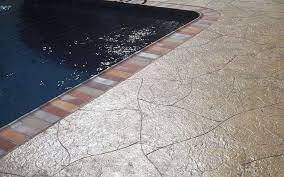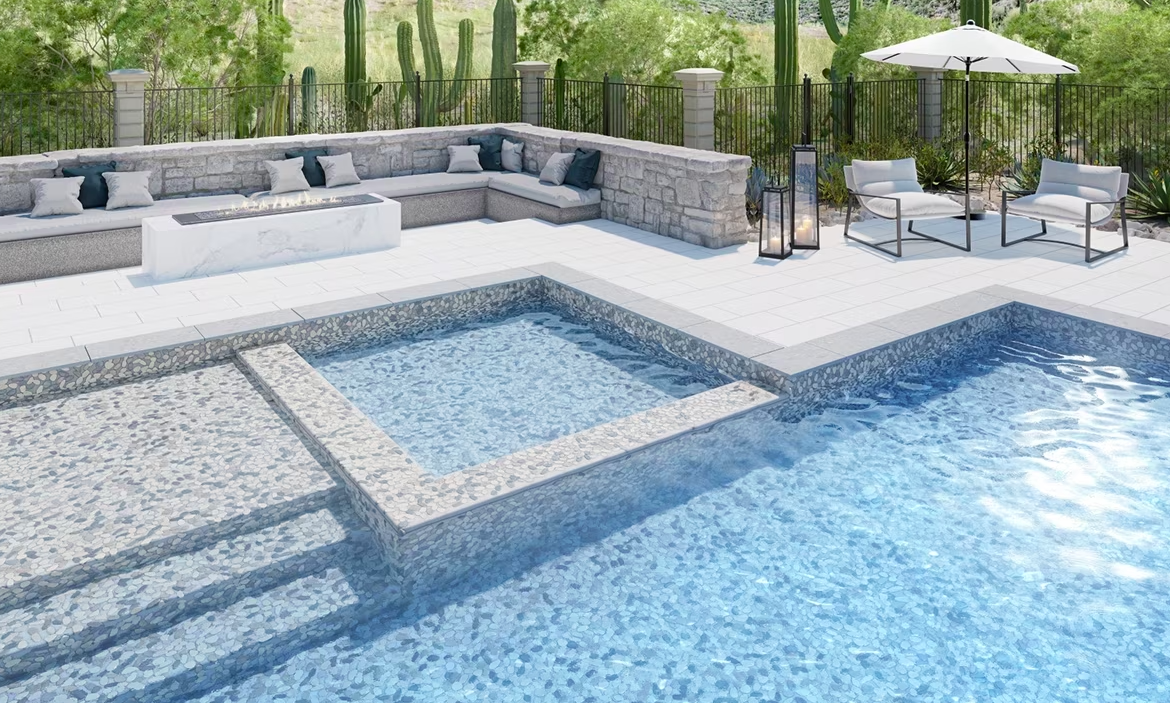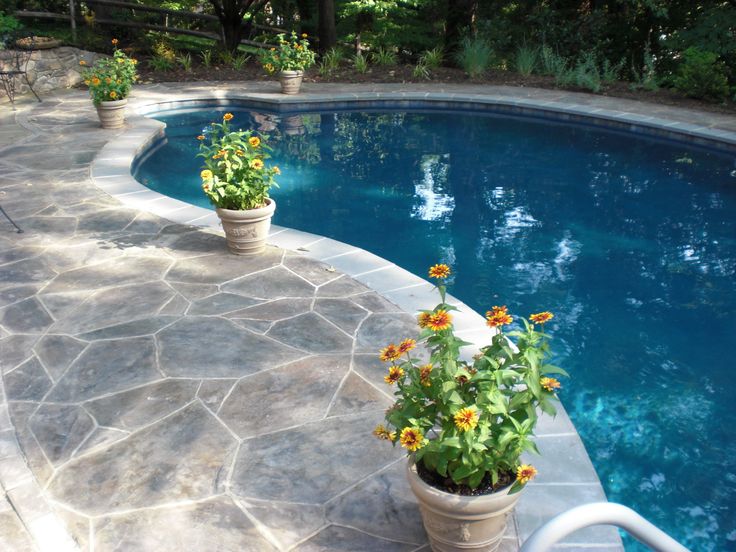Are you hesitant to invest in concrete resurfacing for your pool area because you think it might be too expensive or time-consuming? Think again.
With the art of concrete resurfacing, you can effortlessly transform your pool area into a stunning oasis without breaking the bank. And the best part? It’s a simple process that requires minimal maintenance, allowing you to enjoy your revitalized pool area for years to come.
But how exactly does concrete resurfacing work? Stay tuned as we dive into the details and uncover the secrets behind this transformative technique.
Understanding Concrete Resurfacing
Understanding concrete resurfacing is essential for anyone looking to revitalize the concrete around their pool and create a stunning, durable surface. Concrete resurfacing is a process that involves applying a thin overlay to an existing concrete surface, transforming it into a brand new one. This technique is an excellent solution for pool area revitalization, as it can fix cracks and imperfections, while also offering a wide range of decorative options to enhance the overall look.
When it comes to fixing cracks, concrete resurfacing is a cost-effective alternative to completely replacing the concrete. The overlay material used in the resurfacing process is designed to fill in and seal small cracks, preventing them from getting worse. By addressing these cracks early on, you can avoid more extensive damage and increase the longevity of your pool area.
One of the most appealing aspects of concrete resurfacing is the variety of decorative options available. Whether you’re looking for a classic, elegant look or a more modern, contemporary design, there’s a wide range of colors, patterns, and textures to choose from. You can even incorporate decorative elements like stamped patterns or stenciled designs to create a unique and personalized look for your pool area.
Not only does concrete resurfacing offer aesthetic benefits, but it also provides a durable surface that can withstand the demands of a pool area. The overlay material used in the process is specially formulated to resist water, chemicals, and UV damage, ensuring that your pool area remains in excellent condition for years to come.
Assessing Pool Area Needs
To accurately assess the needs of your pool area, it’s important to evaluate the current condition and identify any specific issues that may require attention. Start by inspecting the concrete surface for any visible damage, such as cracks, chips, or discoloration. These issues not only affect the aesthetic appeal of your pool area but can also pose safety hazards. Look out for any areas where the concrete has become uneven or has started to sink, as this may indicate underlying structural problems. Additionally, check for signs of water damage, such as pooling water or efflorescence, which can indicate poor drainage or waterproofing issues.
Consider the functionality of your pool area as well. Are there any features that need to be added or upgraded? For example, do you need to install handrails or non-slip surfaces to improve safety? Are there any plumbing or electrical systems that require maintenance or repair? Assessing these needs will help ensure that your pool area isn’t only visually appealing but also functional and safe for use.
Don’t forget to consider your personal preferences and style when assessing your pool area. Think about the overall look and feel you want to achieve. Are you interested in a simple, minimalist design or a more elaborate, decorative finish? Take note of any specific design elements or decorative options that you’d like to incorporate into your pool area.
Preparing for Concrete Resurfacing
Before starting the concrete resurfacing process, it’s essential to adequately prepare the pool area to ensure a successful and long-lasting result. Proper preparation not only helps the new surface adhere better but also prevents future issues such as cracking or peeling. Here are some important steps to follow when preparing for concrete resurfacing.
First, thoroughly clean the existing concrete surface. Remove any dirt, debris, or loose material using a pressure washer or a stiff brush. Pay close attention to areas where algae or mold may have grown, as these can affect the adhesion of the new surface. If there are any oil stains, use a degreaser and scrub the area to remove them.
Next, repair any cracks or damage in the concrete. Cracks can be filled with a concrete patching compound, while larger areas of damage may require a resurfacer. Make sure to follow the manufacturer’s instructions for mixing and applying the repair product.
After the repairs, it’s important to profile the surface to improve adhesion. This can be done by etching the concrete with a chemical etching solution or by mechanically grinding the surface. Profiling creates a rough texture that allows the new surface to bond effectively.
Once the surface is clean and properly repaired, it’s time to apply a primer. A primer helps the new surface adhere to the old concrete and improves durability. Follow the manufacturer’s instructions for applying the primer, ensuring an even and thorough coverage.
Choosing Decorative Options
Now that you have properly prepared the pool area for concrete resurfacing, it’s time to explore the exciting world of decorative options to enhance the visual appeal of your new surface. Choosing the right decorative options can completely transform the look and feel of your pool area, creating a stunning and inviting space for you and your guests to enjoy.
One popular decorative option is stamped concrete. This technique involves using stamps to create patterns and textures on the surface of the concrete. You can choose from a wide variety of patterns, such as brick, tile, or even natural stone. Stamped concrete can give your pool area a high-end, luxurious look without the high cost.
Another option to consider is colored concrete. By adding color to the concrete mix, you can achieve a vibrant, customized look for your pool area. Whether you prefer a subtle earth tone or a bold, eye-catching color, there are endless possibilities to choose from. Colored concrete can add depth and character to your pool area, making it truly unique.
If you want to add some sparkle to your pool area, consider using exposed aggregate. This decorative option involves removing the top layer of concrete to reveal the aggregate underneath. The exposed aggregate can be made up of various materials, such as colored glass or natural stones. This creates a beautiful, textured surface that catches the light and adds a touch of elegance to your pool area.
In addition to these decorative options, you can also add borders, patterns, or even custom designs to your pool area. These details can further enhance the visual appeal of your new surface and help create a cohesive and stylish look.
When choosing decorative options for your pool area, it’s important to consider your personal style, the overall theme of your outdoor space, and the level of maintenance and durability you desire. By carefully selecting the right decorative options, you can create a pool area that isn’t only beautiful but also functional and long-lasting.
Maintaining and Extending the Lifespan
Regular maintenance and proper care are essential for maintaining and extending the lifespan of your newly resurfaced pool area. By following a few simple steps, you can ensure that your concrete surface remains in excellent condition for years to come.
Here’s why professional installation is essential for achieving the best results.
Firstly, professionals have the knowledge and experience to properly prepare the area before installing stamped concrete. They’ll assess the condition of the existing surface, make any necessary repairs, and ensure proper drainage to prevent water accumulation. This level of attention to detail is crucial for the longevity of your pool deck.
First and foremost, it’s important to keep your pool area clean. Regularly sweep or hose down the surface to remove any dirt, leaves, or debris. This will prevent them from accumulating and potentially causing damage to the concrete. Additionally, consider using a mild detergent and a soft brush to remove any stains or spills that may occur.
Another crucial aspect of maintenance is to address any cracks or chips immediately. Even small cracks can quickly grow and lead to more significant issues. If you notice any damage, it’s best to contact a professional to assess the situation and make the necessary repairs. This won’t only help maintain the appearance of your pool area but also prevent further deterioration.
In addition to regular cleaning and repairs, it’s crucial to protect your concrete surface from harsh chemicals and extreme weather conditions. Avoid using abrasive cleaning agents or chemicals that can cause discoloration or damage to the surface. Furthermore, consider applying a sealant every few years to provide an extra layer of protection against UV rays, water damage, and staining.
Proper care and maintenance of your resurfaced pool area won’t only extend its lifespan but also ensure that it remains an attractive and functional space for you and your family to enjoy. By following these guidelines and investing a little time and effort, you can enjoy the benefits of your newly revitalized pool area for many years to come.





